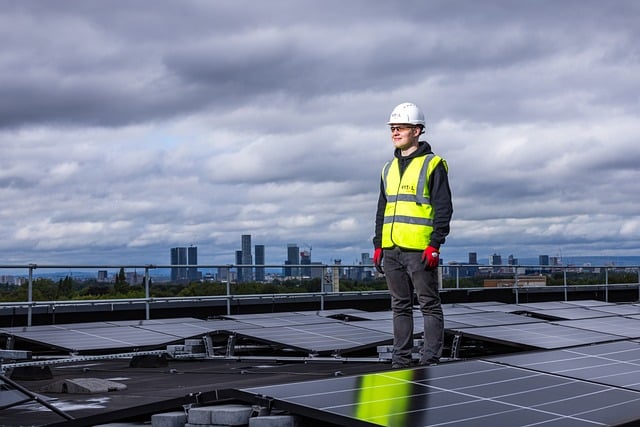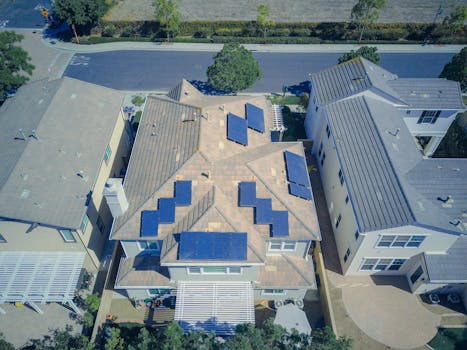“Unlocking Solar Efficiency: Your Guide to Diagnosing Inverter Issues.”
Diagnosing issues with your solar inverter is crucial for maintaining the efficiency and reliability of your solar power system. The inverter plays a vital role in converting the direct current (DC) generated by solar panels into alternating current (AC) for use in your home or for feeding back into the grid. When problems arise, it can lead to reduced energy production and potential system failures. This guide will outline the common symptoms of inverter issues, the steps to troubleshoot them, and tips for ensuring optimal performance, helping you to quickly identify and resolve any problems that may affect your solar energy system.
Common Signs of Solar Inverter Malfunction
Diagnosing issues with your solar inverter is crucial for maintaining the efficiency and longevity of your solar energy system. Understanding the common signs of solar inverter malfunction can help you identify problems early and take appropriate action. One of the most noticeable indicators of an inverter issue is a sudden drop in energy production. If you observe that your solar panels are generating significantly less power than usual, it may be a sign that the inverter is not functioning correctly. This drop can often be attributed to various factors, including shading, dirt on the panels, or, more critically, a malfunctioning inverter.
Another common sign of inverter trouble is the presence of warning lights or error messages on the inverter display. Most modern inverters are equipped with diagnostic features that alert users to potential issues. If you notice a red light or an error code, it is essential to consult the inverter’s manual to understand the specific problem indicated. Ignoring these warnings can lead to more severe issues down the line, so it is advisable to address them promptly.
In addition to visual indicators, unusual sounds coming from the inverter can also signal a malfunction. A properly functioning inverter should operate quietly, so any buzzing, clicking, or humming noises may warrant further investigation. These sounds could indicate internal component failure or overheating, both of which can compromise the inverter’s performance. If you hear any strange noises, it is wise to turn off the system and consult a professional for a thorough inspection.
Temperature fluctuations can also be a sign of inverter issues. Solar inverters are designed to operate within a specific temperature range. If you notice that the inverter is excessively hot to the touch or, conversely, not warming up at all, it may be experiencing problems. Overheating can lead to thermal shutdowns, which prevent the inverter from functioning altogether. Conversely, if the inverter is not reaching its optimal operating temperature, it may indicate a failure in the internal components. Monitoring the temperature of your inverter regularly can help you catch these issues early.
Moreover, if you experience frequent system shutdowns or resets, this could indicate a malfunctioning inverter. While occasional shutdowns can occur due to external factors like grid issues or maintenance, repeated occurrences suggest that the inverter may not be handling the load effectively. This could be due to a variety of reasons, including software glitches or hardware failures. Keeping a log of these incidents can provide valuable information for technicians when diagnosing the problem.
Lastly, if you notice that your inverter is not communicating with your monitoring system, this could be another sign of malfunction. Many solar systems come equipped with monitoring capabilities that allow you to track energy production and system performance. If the monitoring system is not receiving data from the inverter, it may indicate a communication failure, which can stem from wiring issues or internal faults within the inverter itself.
In conclusion, being vigilant about these common signs of solar inverter malfunction can help you maintain the efficiency of your solar energy system. By recognizing issues such as reduced energy production, warning lights, unusual sounds, temperature fluctuations, frequent shutdowns, and communication failures, you can take proactive steps to diagnose and address problems before they escalate. Regular maintenance and timely intervention are key to ensuring that your solar inverter continues to operate effectively, allowing you to enjoy the benefits of renewable energy without interruption.
Step-by-Step Guide to Troubleshooting Solar Inverters

Diagnosing issues with your solar inverter can seem daunting, but with a systematic approach, you can identify and resolve many common problems. The first step in troubleshooting is to familiarize yourself with the inverter’s display panel, which often provides valuable information about its operational status. Begin by checking for any error codes or warning lights. Most modern inverters are equipped with diagnostic features that can indicate specific issues, such as grid connection problems or system overloads. If you notice any alerts, consult the inverter’s manual to understand what these codes mean and how they can guide your troubleshooting efforts.
Once you have assessed the display panel, the next step is to ensure that the inverter is receiving adequate sunlight. Solar inverters rely on solar panels to generate electricity, so if the panels are dirty, shaded, or damaged, the inverter may not function properly. Inspect the solar panels for any obstructions, such as leaves or debris, and clean them if necessary. Additionally, check for any shading from nearby trees or buildings that could be affecting the panels’ performance. If you find any issues, addressing them can significantly improve the inverter’s efficiency.
After confirming that the solar panels are in good condition, it is essential to examine the electrical connections. Loose or corroded connections can lead to power loss and may trigger error codes on the inverter. Start by turning off the inverter and inspecting all wiring and connections for signs of wear or damage. Ensure that all connections are tight and secure. If you notice any corrosion, clean the affected areas with a suitable electrical contact cleaner. Once you have checked the connections, turn the inverter back on and monitor its performance.
In addition to checking the physical components, it is also important to evaluate the inverter’s settings. Sometimes, incorrect settings can lead to operational issues. Access the inverter’s configuration menu, usually available through the display panel or a connected app, and verify that all settings align with the manufacturer’s recommendations. Pay particular attention to parameters such as grid voltage and frequency, as deviations from the norm can cause the inverter to shut down or operate inefficiently.
If the inverter continues to exhibit problems after these initial checks, it may be time to delve deeper into its internal components. Some inverters have built-in self-diagnostic tools that can provide insights into internal faults. If your inverter supports this feature, run the diagnostic test and take note of any findings. This information can be invaluable when seeking professional assistance, as it can help technicians pinpoint the issue more quickly.
Finally, if you have exhausted all troubleshooting steps and the inverter remains unresponsive or continues to display error codes, it may be necessary to contact a qualified technician. Solar inverters are complex devices, and some issues may require specialized knowledge and tools to resolve. When reaching out for professional help, be prepared to provide detailed information about the symptoms you have observed and the steps you have already taken to troubleshoot the problem.
In conclusion, diagnosing issues with your solar inverter involves a methodical approach that includes checking the display panel, ensuring adequate sunlight, inspecting electrical connections, verifying settings, and utilizing diagnostic tools. By following these steps, you can often identify and resolve common problems, ensuring that your solar energy system operates efficiently and effectively. If all else fails, do not hesitate to seek professional assistance to restore your system to optimal performance.
Tools Needed for Diagnosing Solar Inverter Issues
Diagnosing issues with a solar inverter requires a systematic approach and the right tools to ensure accurate assessments and effective solutions. To begin with, a multimeter is an essential instrument for any technician or homeowner looking to troubleshoot solar inverter problems. This versatile device allows users to measure voltage, current, and resistance, providing critical insights into the inverter’s performance. By checking the input and output voltages, one can determine whether the inverter is functioning within its specified parameters. If discrepancies arise, it may indicate a malfunction that requires further investigation.
In addition to a multimeter, a clamp meter can be particularly useful for diagnosing issues related to current flow. Unlike a traditional multimeter, a clamp meter can measure the current without needing to disconnect any wires, making it a safer and more convenient option for assessing the inverter’s performance. By clamping the meter around the output wires, users can quickly determine if the current is within the expected range, which can help identify potential problems with the inverter or the connected solar panels.
Another valuable tool for diagnosing solar inverter issues is a solar irradiance meter, also known as a pyranometer. This device measures the amount of solar energy hitting the panels, allowing users to assess whether the inverter is receiving adequate sunlight for optimal performance. If the irradiance levels are low, it may not be the inverter that is malfunctioning, but rather environmental factors such as shading or dirt accumulation on the panels. By using a solar irradiance meter, one can rule out external factors and focus on the inverter itself if performance issues persist.
Furthermore, a thermal imaging camera can be an invaluable asset when diagnosing solar inverter problems. This tool allows users to visualize heat patterns, which can reveal hotspots or areas of overheating within the inverter. Overheating components can indicate electrical faults or inefficiencies, and identifying these issues early can prevent further damage and costly repairs. By incorporating thermal imaging into the diagnostic process, technicians can gain a deeper understanding of the inverter’s operational health.
In addition to these tools, having access to the inverter’s user manual and technical specifications is crucial for effective troubleshooting. The manual often contains valuable information regarding error codes, operational parameters, and recommended maintenance practices. By consulting the manual, users can better understand the inverter’s design and functionality, which can aid in pinpointing issues more accurately.
Moreover, software tools and apps designed for monitoring solar inverter performance can provide real-time data and historical performance trends. Many modern inverters come equipped with monitoring capabilities that allow users to track their system’s efficiency remotely. By analyzing this data, one can identify patterns or anomalies that may indicate underlying issues, enabling a more informed approach to diagnostics.
In conclusion, diagnosing issues with a solar inverter necessitates a combination of the right tools and a methodical approach. By utilizing a multimeter, clamp meter, solar irradiance meter, thermal imaging camera, and leveraging software monitoring tools, users can effectively assess the health of their solar inverter. Coupled with a thorough understanding of the inverter’s specifications and operational guidelines, these tools empower individuals to identify and address issues promptly, ensuring the continued efficiency and reliability of their solar energy systems.
When to Seek Professional Help for Solar Inverter Problems
When it comes to maintaining the efficiency and longevity of your solar energy system, understanding when to seek professional help for solar inverter problems is crucial. Solar inverters play a vital role in converting the direct current (DC) generated by solar panels into alternating current (AC) that can be used in your home or fed back into the grid. However, like any electronic device, inverters can encounter issues that may require expert intervention. Recognizing the signs of trouble is the first step in ensuring your system continues to operate optimally.
One of the primary indicators that you may need to consult a professional is a sudden drop in energy production. If you notice that your solar system is not generating as much power as it used to, it could be a sign of an inverter malfunction. While fluctuations in energy output can occur due to weather conditions or shading, a consistent decline may indicate a deeper issue. In such cases, it is advisable to contact a qualified technician who can perform a thorough diagnostic assessment.
Another critical sign that professional help is warranted is the presence of warning lights or error codes on your inverter. Most modern inverters are equipped with monitoring systems that alert users to potential problems. If you see a red light or an error message on the display, it is essential to take these warnings seriously. While some minor issues can be resolved by resetting the inverter or checking connections, persistent error codes often require the expertise of a trained technician who can accurately diagnose and rectify the problem.
Moreover, unusual noises emanating from your inverter can also signal the need for professional assistance. Inverters are designed to operate quietly, so any grinding, buzzing, or clicking sounds may indicate internal components are failing or that there is an electrical issue. Ignoring these sounds can lead to more significant problems down the line, including complete inverter failure. Therefore, if you hear anything out of the ordinary, it is wise to consult an expert who can investigate the source of the noise and recommend appropriate repairs.
In addition to these specific signs, it is also important to consider the age of your inverter. Most inverters have a lifespan of around 5 to 10 years, depending on the model and usage. If your inverter is approaching or has surpassed this age range, it may be more susceptible to issues. Regular maintenance checks by a professional can help identify potential problems before they escalate, ensuring that your system remains efficient and reliable.
Furthermore, if you have attempted basic troubleshooting—such as checking connections, resetting the inverter, or reviewing the monitoring app—and have not seen any improvement, it is time to call in a professional. DIY fixes can sometimes lead to further complications, especially if you are not familiar with the intricacies of solar technology. A qualified technician will have the knowledge and tools necessary to diagnose the issue accurately and implement effective solutions.
In conclusion, knowing when to seek professional help for solar inverter problems is essential for maintaining the efficiency of your solar energy system. By being vigilant about energy production, monitoring warning signals, and recognizing the limitations of DIY troubleshooting, you can ensure that your solar inverter remains in optimal working condition. Ultimately, timely intervention by a professional can save you from costly repairs and extend the life of your solar investment.
Q&A
1. **Question:** What are common signs that my solar inverter may be malfunctioning?
**Answer:** Common signs include a sudden drop in energy production, error messages on the display, unusual noises, or the inverter not turning on.
2. **Question:** How can I check if my solar inverter is producing power?
**Answer:** You can check the inverter’s display panel for output readings or use a solar monitoring app if available. Additionally, you can measure the AC output with a multimeter.
3. **Question:** What should I do if my inverter shows an error code?
**Answer:** Refer to the inverter’s user manual to identify the error code and follow the recommended troubleshooting steps, which may include resetting the inverter or checking connections.
4. **Question:** How can I inspect the physical condition of my solar inverter?
**Answer:** Visually inspect the inverter for any signs of damage, such as burnt components, corrosion, or loose wiring. Ensure that the inverter is clean and free from debris.
Conclusion
To diagnose issues with your solar inverter, start by checking the inverter display for error codes or warning lights, which can indicate specific problems. Ensure that the inverter is receiving adequate sunlight and that all connections are secure. Inspect the circuit breakers and fuses for any tripped or blown components. Monitor the system’s performance data through the inverter’s app or monitoring system to identify any irregularities in energy production. If issues persist, consult the manufacturer’s manual for troubleshooting steps or contact a professional technician for further assistance. Regular maintenance and prompt attention to warning signs can help ensure optimal performance of your solar inverter.




